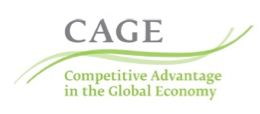This briefing paper puts forward comprehensive evidence on prices and crime for a large range of goods, focusing on monthly data for London over 2002-2012.
It finds that crime is responsive to prices across the large range of goods.
This is the sixth briefing paper in the Global Perspectives series, a collaboration between the Social Market Foundation and the University of Warwick’s Centre for Competitive Advantage in the Global Economy (CAGE).
SUMMARY
- Crime has fallen across many countries since the early 1990s. A range of explanations have been put forward, including the level of police resources, the incidence of drug epidemics, demographic factors (including the effects of abortion and lead pollution on the crime propensity of different age cohorts), and incarceration rates.
- Another plausible explanation for changes in the rate of property crime, though one that has received far less attention, is prices. As the prices of commonly stolen goods change then so does the return to property crime.
- This briefing paper puts forward comprehensive evidence on prices and crime for a large range of goods, focusing on monthly data for London over 2002-2012. We find that crime is responsive to prices across the large range of goods we study with elasticities in the region of 0.35-0.40. This indicates that, for example, a 10% increase in prices is associated with a 3.5% increase in crime.
- We further analyse a sub-set of commodity-related goods – jewellery, fuel and metals. These goods offer a clean quasi-experimental setting to look at the effects of a pure change in price on criminal activity. Specifically, they are homogenous in their quality and supported by efficient resale markets (for example, the scrap metal recycling industry). Price changes for these goods are also exogenous since they are driven by trends in international commodity prices.
- Practically, these conditions mean that price changes are unlikely to be driven by local UK economic patterns that could also be influencing crime through other channels. Overall, this further analysis confirms the existence of a significant, causal crime-price relationship, especially for metals where there was a price-induced crime boom in the mid-to-late 2000s.
- We also compare the effect of a ‘stolen goods price index’ on crime to the effect of changes in wages. We find that the index tracks aggregate crime more closely than wages; and that over 20% of the trend fall in crime can be explained by prices at the aggregate level.
- A crucial policy implication of this analysis is that, since the returns to crime matter so significantly, investments in security have potentially more leverage in reducing crime than previously thought. For example, the spread of technologies that aid device security (e.g. tracking devices such as ‘find my iphone’) have the effect of lowering the net returns to theft. Provided that criminals find it difficult or costly to adapt to and overcome such technologies, investments in security have the potential to kill off the incentives for theft.
- Another policy implication relates to ‘predictive policing’. Since crime tracks the value of goods so tightly it would be viable to begin planning police responses to theft as market prices start to rise or fall. For example, increases in metals or other commodity prices could be used as a signal to increase monitoring or patrols relating to the potential theft of these goods.
Download The Report: PDF
Kindly supported by

